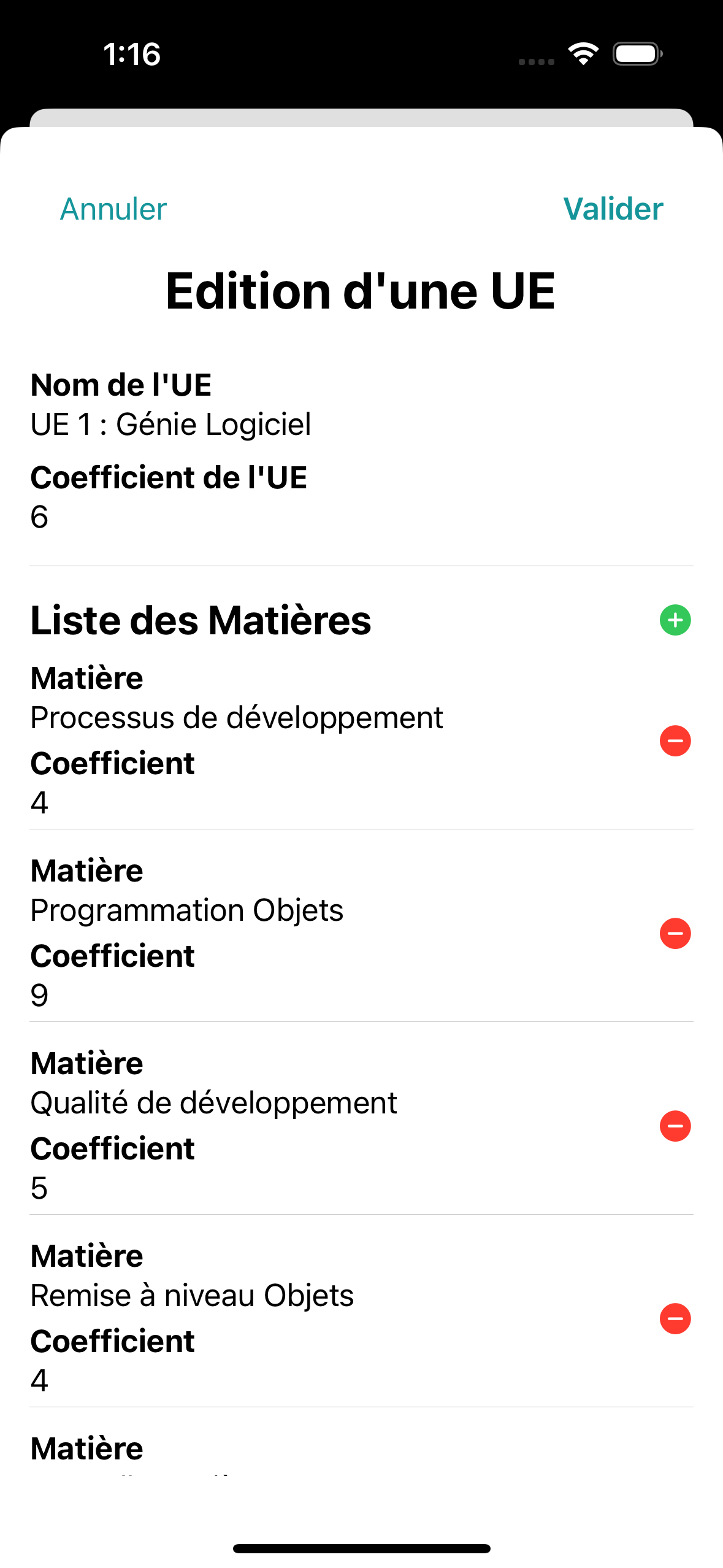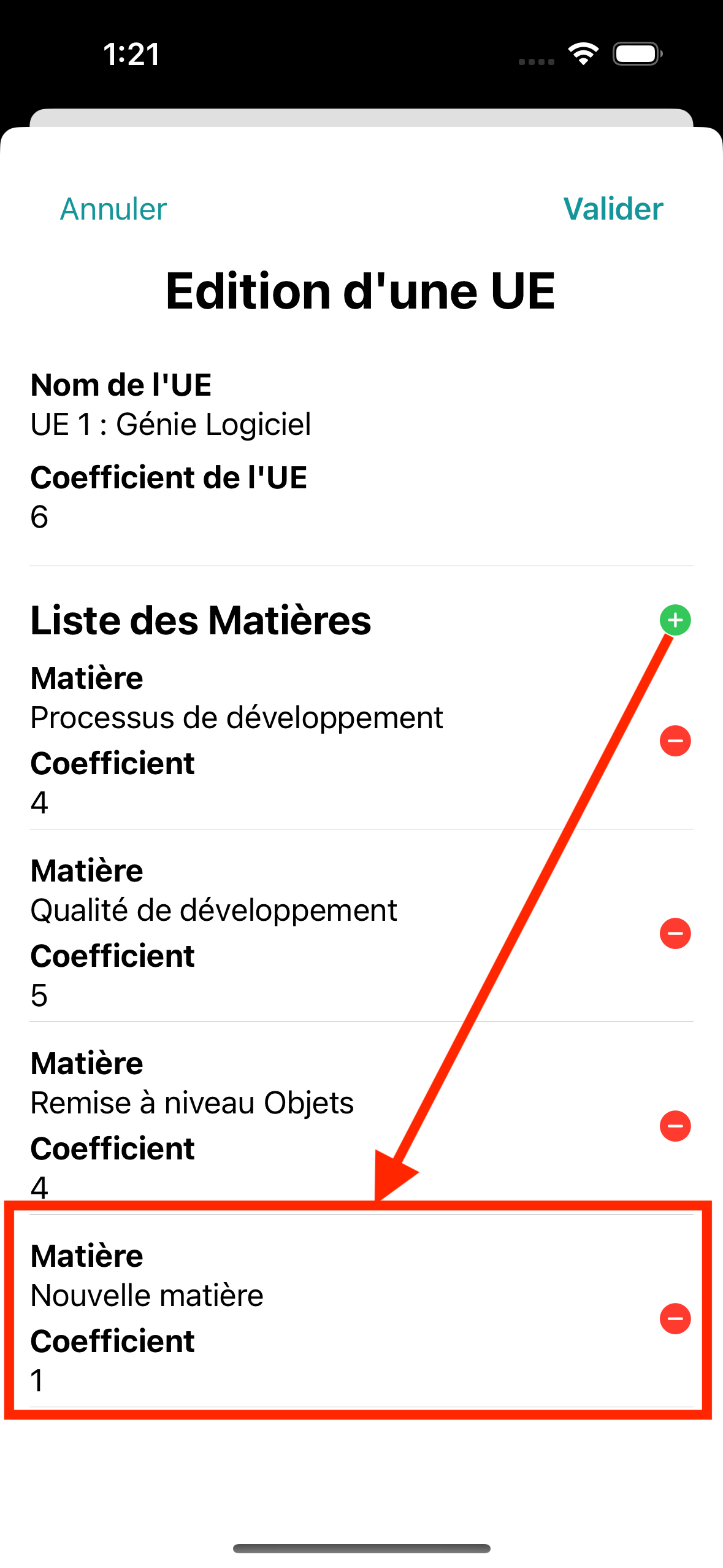This project is a calculator developed with SwiftUI that calculates your average. It allows you to display your notes in each block and each subject. A color code is in place to let you know if you have a good grade or not. You can simulate your notes by adjusting the sliders.
This project uses an MVVM architecture adapted for SwiftUI. You can find some explanations here.
You can find the instructions here.
- List all blocks
- List all units
- Detail of one unit
- List courses in unit
-
Capsule- Adjust grade of the course
- Lock
Capsuleto lock the grade - Color code
- Edit unit
- Name
- Coefficient
- Add course in unit
- Edit course in unit
- Delete course in unit
- Json persistence
- Navigation
- Pages
- Custom Views
- Bindings (State, Binding, StateObject, ObservedObject)
- Notifications with
Hashable - Generic Viewmodel for editing
In this section, I will explain the concept of MVVM architecture in SwiftUI. All the architecture is explained here.
Apple strongly recommends using structures in Swift. So we will follow the guidelines to write our model.
@startuml
protocol Identifiable
protocol Equatable
protocol Codable
note as n1
All the structures implements the
protocols Identifiable, Equatable and Codable
end note
n1 .. Identifiable
n1 .. Codable
n1 .. Equatable
struct Block {
+ id: UUID
+ name: String
+ average: Float
+ init(id: UUID, name: String, units: [UCAUnit])
+ init(id: UUID, name: String)
+ init(name: String, units: [UCAUnit])
+ init(name: String)
+ updateUnit(unit: UCAUnit)
}
note left of Block::average
This field is a computed value
that calculate the weighted
average of all units in the block.
end note
struct UCAUnit {
+ id: UUID
+ name: String
+ coef: Int
+ average: Float
+ init(id: UUID, name: String, coef: Int, courses: [Course])
+ init(id: UUID, name: String, coef: Int)
+ init(name: String, coef: Int, courses: [Course])
+ init(name: String, coef: Int)
+ addCourse(name: String, coef: Int, mark: Float)
+ updateCourse(course: Course)
+ removeCourse(id: UUID)
+ same(other: Course): Bool
}
note left of UCAUnit::average
This field is a computed value
that calculate the weighted
average of all the courses in the unit.
end note
struct Course {
+ id: UUID
+ name: String
+ coef: Int
+ mark: Float
+ init(id: UUID, name: String, coef: Int, mark: Float)
+ init(name: String, coef: Int, mark: Float)
+ same(other: Course): Bool
}
protocol DataManagerProtocol {
load(): [Block]
save(blocks: [Block])
}
UCAUnit --> "courses *" Course
Block --> "units *" UCAUnit
@endumlThe views will bind to the property wrapped by the viewmodel and will send user actions to the viewmodel to execute logics.
The main view, in this project HomePage, will own the top viewmodel OdinVm as @StateObject. This viewmodel will be passed to other views with @ObservedObject.
@startuml
class OdinVm
class BlockVm
class UnitVm
class CourseVm
struct HomePage {
+ @StateObject odinVm: OdinVm
}
struct UEDetailPage
struct BlocksView {
+ @ObservedObject odinVm: OdinVm
}
struct UEListView {
+ @ObservedObject blockVm: BlockVm
}
struct BlockRowView
struct UESummaryView
struct UEEditView
struct MarkSlider
struct CourseView
struct CourseItemView
struct CourseEditView
HomePage -up-> OdinVm
HomePage ..> BlocksView
HomePage ..> UEListView
BlocksView -up-> OdinVm
BlocksView ..> BlockRowView
BlockRowView -up-> BlockVm
UEListView -up-> BlockVm
UEListView ..> UESummaryView
UEListView ..> UEDetailPage
UESummaryView -up-> UnitVm
UESummaryView ..> MarkSlider
UEDetailPage -up-> UnitVm
UEDetailPage ..> CourseView
UEDetailPage ..> UEEditView
CourseView -up-> CourseVm
CourseView ..> CourseItemView
CourseItemView ..> MarkSlider
CourseItemView -up-> CourseVm
UEEditView -up-> UnitVm
UEEditView ..> CourseEditView
@endumlViewmodels in Swift is composed of two main points:
- Wrapping
- Editing
- Notifications
Even if structures are heavily used and advised in Swift, viewmodels have to be classes in order to use the observable mechanism.
@startuml
protocol ObservableObject
struct Course
struct UCAUnit
struct Block
class OdinVm {
+ @Published blocks: [BlockVm]
}
class BlockVm
class UnitVm
class CourseVm
OdinVm .up.|> ObservableObject
BlockVm .up.|> ObservableObject
UnitVm .up.|> ObservableObject
CourseVm .up.|> ObservableObject
OdinVm --> "*" BlockVm
BlockVm --> "*" UnitVm
BlockVm --> "1" Block
Block --> "*" UCAUnit
UnitVm --> "*" CourseVm
UnitVm --> "1" UCAUnit
UCAUnit --> "*" Course
CourseVm --> "1" Course
@endumlThe first goal of the Viewmodel is to wrapped the model and all properties of the model in order to separate the View from the Model and the Model from the View.
All viewmodels must conform to the ObservableObject protocol. This protocol indicates that the object conforming to it, is attached to a publisher that emits nofitications just before the object has changed.
All properties in the Viewmodel must be mark @Published to benefiting from the notification system.
The editing part will provide a copy of the actuel Viewmodel, this copy will be used by the edition view as binding property. The user will entered in edition mode with onEditing() method then the copy property will be set with a copy of the actuel model wrapped in the viewmodel. At the end of edition, the viewmodel will copy the model of the copy into himself to update its model with the new model.
The viewmodel provide a isEditing property to know the state of the edition.
@startuml
class CourseVm {
+ isEditing: Bool
+ copy: CourseVm?
+ onEditing()
+ onEdited(cancel: Bool)
}
@endumlThe notification part is to set up the Observer/Observable pattern. This pattern allows to send notifications to an unknown object which has subscribed to notifications.
In Swift, we will write this pattern with callbacks.
When the view updates the viewmodel by the properties, the viewmodel changes the property of the wrapped model thanks to the didSet of the property. After that, it will fire the onModelChanged() to tell to the subscribers that the model has changed.
@startuml
class BaseVm {
- updatedCallbacks: [(BaseVm) -> ()]
+ addUpdatedCallback(callback: (BaseVm) -> ())
+ onModelChanged()
}
@enduml- iOS 13
- XCode 14.3
- iOS Simulator or iOS Device
- Clone the repo
git clone https://codefirst.iut.uca.fr/git/florent.marques/ucaverage-ios.git
- Open the project with XCode
- Run the project on iOS Simulator or iOS Device
- Enjoy your application





